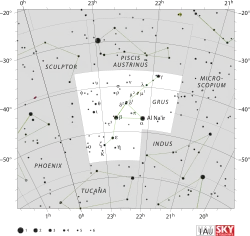Gamma Gruis
Gamma Gruis (γ Gruis, abbreviated Gam Gru, γ Gru), formally named Aldhanab /ˈældənæb/,[11] is a star in the southern constellation of Grus (it once belonged to the Ptolemaic constellation Piscis Austrinus). With an apparent visual magnitude of 3.0,[2] it is the third-brightest star in Grus. Based upon parallax measurements, this star is located at a distance of roughly 211 light-years (65 parsecs) from the Sun.[1]

| |
| Observation data Epoch J2000 Equinox J2000 | |
|---|---|
| Constellation | Grus |
| Right ascension | 21h 53m 55.72620s[1] |
| Declination | –37° 21′ 53.4790″[1] |
| Apparent magnitude (V) | 3.003[2] |
| Characteristics | |
| Spectral type | B8 III[3] |
| U−B color index | –0.307[2] |
| B−V color index | –0.121[2] |
| Astrometry | |
| Radial velocity (Rv) | –2.1[4] km/s |
| Proper motion (μ) | RA: +98.07[1] mas/yr Dec.: –13.22[1] mas/yr |
| Parallax (π) | 15.45 ± 0.67[1] mas |
| Distance | 211 ± 9 ly (65 ± 3 pc) |
| Absolute magnitude (MV) | −1.05[5] |
| Details | |
| Mass | 3.06[6] M☉ |
| Radius | 4.5[7] R☉ |
| Luminosity | 373[5] L☉ |
| Surface gravity (log g) | 3.79[6] cgs |
| Temperature | 12,520[8] K |
| Rotational velocity (v sin i) | 57[9] km/s |
| Age | 75[6] Myr |
| Other designations | |
| Database references | |
| SIMBAD | data |
Nomenclature
γ Gruis (Latinised to Gamma Gruis) is the system's Bayer designation.
It bore the traditional Arabic name Al Dhanab, from the Arabic الذنب al-dhanab "the tail" (of the Southern Fish).[12] In 2016, the IAU organized a Working Group on Star Names (WGSN)[13] to catalog and standardize proper names for stars. The WGSN approved the name Aldhanab for this star on 5 September 2017 and it is now so included in the List of IAU-approved Star Names.[11]
In Chinese, 敗臼 (Bài Jiù), meaning Decayed Mortar, refers to an asterism consisting of Gamma Gruis, Lambda Gruis, Gamma Piscis Austrini and 19 Piscis Austrini.[14] Consequently, the Chinese name for Gamma Gruis itself is 敗臼一 (Bài Jiù yī, English: the First Star of Decayed Mortar.)[15]
Properties
Analysis of the spectrum shows it to match a stellar classification of B8 III,[3] with the luminosity class of III indicating this is a giant star that has exhausted the supply of hydrogen at its core and evolved away from the main sequence. The luminosity of Gamma Gruis is around 390 times that of the Sun, with a significant portion of the energy emission being in the ultraviolet.[16] Its outer envelope has an effective temperature of 12,520 K,[8] which gives the star a blue-white hue. Gamma Gruis is rotating relatively rapidly with a projected rotational velocity of 57 km s−1.[9] By way of comparison, the Sun has an azimuthal velocity along its equator of just 2 km s−1.
Based upon analysis of data collected during the Hipparcos mission, this star may have a proper motion companion that is causing gravitational perturbation of Gamma Gruis.[17]
See also
References
- van Leeuwen, F. (November 2007), "Validation of the new Hipparcos reduction", Astronomy and Astrophysics, 474 (2): 653–664, arXiv:0708.1752, Bibcode:2007A&A...474..653V, doi:10.1051/0004-6361:20078357, S2CID 18759600
- Gutierrez-Moreno, Adelina; et al. (1966). "A System of photometric standards". Publications of the Department of Astronomy University of Chile. Publicaciones Universidad de Chile, Department de Astronomy. 1: 1–17. Bibcode:1966PDAUC...1....1G.
- Houk, Nancy (1979), Michigan catalogue of two-dimensional spectral types for the HD stars, 3, Ann Arbor, Michigan: Dept. of Astronomy, University of Michigan, Bibcode:1982mcts.book.....H
- Wilson, R. E. (1953). "General Catalogue of Stellar Radial Velocities". Carnegie Institute Washington D.C. Publication. Carnegie Institute of Washington D.C. Bibcode:1953GCRV..C......0W.
- Anderson, E.; Francis, Ch. (2012), "XHIP: An extended hipparcos compilation", Astronomy Letters, 38 (5): 331, arXiv:1108.4971, Bibcode:2012AstL...38..331A, doi:10.1134/S1063773712050015, S2CID 119257644.
- David, Trevor J.; Hillenbrand, Lynne A. (2015), "The Ages of Early-Type Stars: Strömgren Photometric Methods Calibrated, Validated, Tested, and Applied to Hosts and Prospective Hosts of Directly Imaged Exoplanets", The Astrophysical Journal, 804 (2): 146, arXiv:1501.03154, Bibcode:2015ApJ...804..146D, doi:10.1088/0004-637X/804/2/146, S2CID 33401607.
- Underhill, A. B.; et al. (November 1979), "Effective temperatures, angular diameters, distances and linear radii for 160 O and B stars", Monthly Notices of the Royal Astronomical Society, 189 (3): 601–605, Bibcode:1979MNRAS.189..601U, doi:10.1093/mnras/189.3.601
- Zorec, J.; et al. (July 2009), "Fundamental parameters of B supergiants from the BCD system. I. Calibration of the (λ_1, D) parameters into Teff", Astronomy and Astrophysics, 501 (1): 297–320, arXiv:0903.5134, Bibcode:2009A&A...501..297Z, doi:10.1051/0004-6361/200811147, S2CID 14969137
- Royer, F.; et al. (2002), "Rotational velocities of A-type stars in the northern hemisphere. II. Measurement of v sin i in the northern hemisphere", Astronomy and Astrophysics, 393 (3): 897–911, arXiv:astro-ph/0205255, Bibcode:2002A&A...393..897R, doi:10.1051/0004-6361:20020943, S2CID 14070763
- "gam Gru". SIMBAD. Centre de données astronomiques de Strasbourg. Retrieved 2007-03-30.
- "Naming Stars". IAU.org. Retrieved 16 December 2017.
- Allen, R. H. (1963), Star Names: Their Lore and Meaning (Reprint ed.), New York, NY: Dover Publications Inc., p. 238, ISBN 0-486-21079-0
- "IAU Working Group on Star Names (WGSN)". Retrieved 22 May 2016.
- (in Chinese) 中國星座神話, written by 陳久金. Published by 台灣書房出版有限公司, 2005, ISBN 978-986-7332-25-7.
- (in Chinese) AEEA (Activities of Exhibition and Education in Astronomy) 天文教育資訊網 2006 年 7 月 5 日
- Kaler, James B., "AL DHANAB (Gamma Gruis)", Stars, University of Illinois, retrieved 2012-02-11
- Frankowski, A.; Jancart, S.; Jorissen, A. (March 2007), "Proper-motion binaries in the Hipparcos catalogue. Comparison with radial velocity data", Astronomy and Astrophysics, 464 (1): 377–392, arXiv:astro-ph/0612449, Bibcode:2007A&A...464..377F, doi:10.1051/0004-6361:20065526, S2CID 14010423